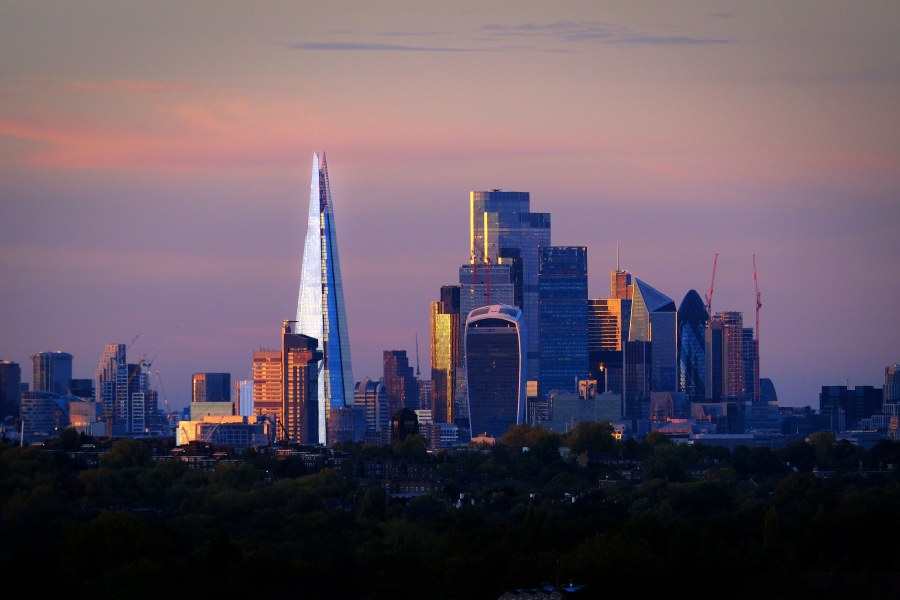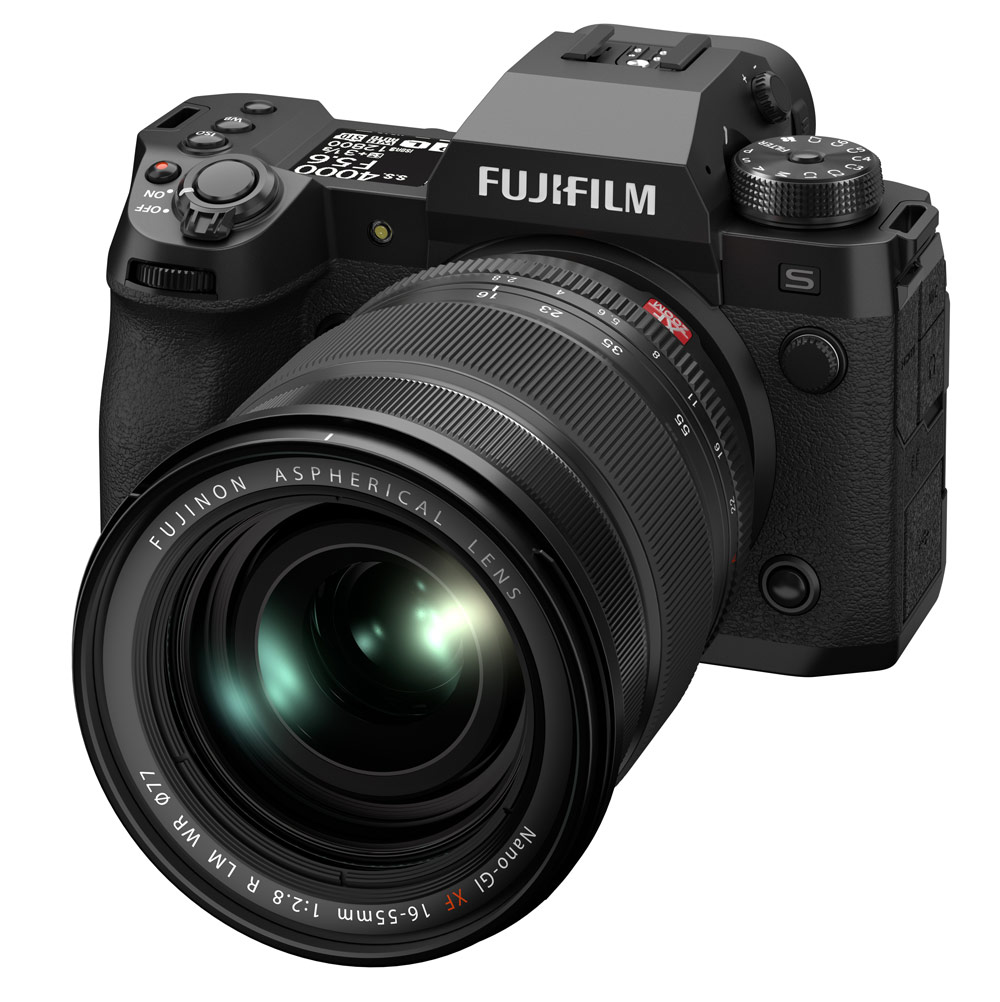The Fujifilm X-H2S is one of the best Fujifilm cameras, particularly excelling in sports and action. Here, Chief Photographer and Picture Editor on the newspaper City A.M Andy Blackmore finds out how it does by taking the Fujifilm’s 26MP flagship to work.
Fujifilm X-H2S at a glance:
- 26.1MP stacked BSI X-Trans CMOS 5 HS sensor
- Up to 15 fps (mechanical shutter), 40 fps (electronic shutter)
- In-body stabilization rated at up to 7EV
- 5.76M-dot, 0.8x OLED EVF, up to 120fps
- 3-inch 1.62M-dot vari-angle LCD
- Weather resistant body
- Fujifilm X mount
It’s a funny old world; one where perception and reality are so often worlds apart. Take press photography for instance. Imagine the reader, binging such films as “The Bang Bang Club”, “Blow-Up” and “Minamata”. By now, they believe that life in this universe is a dangerous, exhilarating and glamorous cocktail, an intoxicating combination of dodging bullets, bouncers, and annoying PR types, while romping through the Colorama alongside models juggling Leicas. As, flash, bang, wallop, one (conveniently) always seems to be at the right place, at the right time, to take “that” photograph.
Now, I hate to burst such laughable bubbles of misconception, however enviable. Whilst I’ve had my share of excitement and some danger, the nearest I’ve come to “Blow-Up” is working alongside the brilliant Janet Street-Porter (who is in the film) when she was my Editor at the Independent on Sunday. Quite frankly, life as a press photographer is not nearly as exciting as you might care to conceive. Well, that is unless you have a masochistic imagination that conjures up thoughts of jogging to avoid losing the light, getting soaking wet, and suffering both backache and boredom.
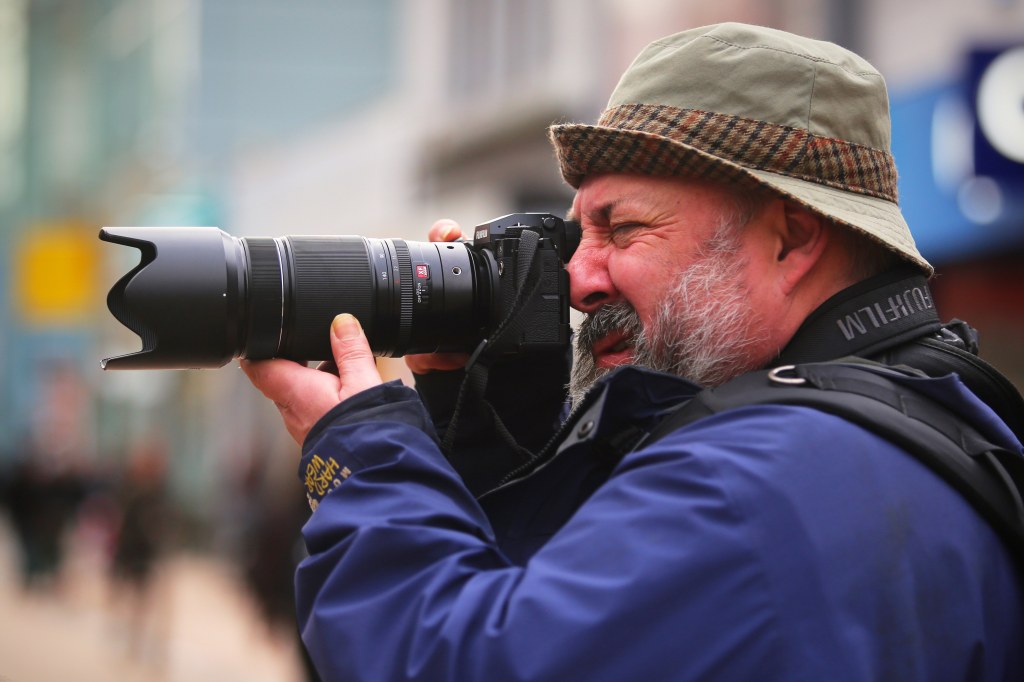
Andy Blackmore testing out the Fuji X-H2S in Croydon town centre. Photo Credit: Gretel Ensignia
No, here in the real world, working as Chief Photographer and Picture Editor on the newspaper City A.M. is a complex personal dichotomy, comprising in equal measures; love and hate, passion and apathy, and monotony and variety. A stressful mix all of my own making, making the most out of what can often feel like a chronic lack of time and resources; and above all, the most morale-sapping of creative evils – the lack of potential for creativity.
Fujifilm X-H2S – Tool for the job
Imagine being commanded to bake a splendid cake. However, to further spice things up, your vindictive taskmaster restricts you to the value brand aisle for ingredients. And believe me, that is a challenge in itself, so the last thing you need is more strain worrying whether your oven is baking at the proper temperature and the accuracy of its timer. Now, that baking analogy is simply a way of saying that a camera is just a tool. And photographers, just like artisan bakers, rely on those tools doing exactly what they expect, exactly when they expect it.
All of which brings us neatly to the Fujifilm X-H2S. Now, I’ve only recently moved over to Fujifilm from what feels like a lifetime of shooting on Canon. So much so, that whilst there is a Fuji in the bag, I’ve still got a Canon in the brain. By that, I mean that so much of what a photographer does when using his equipment becomes instinctive. At times it seemed like actions were running in the background of my brain with tasks completed with little thought, seemingly on muscle memory alone. We are not at that stage with Fujifilm – yet – but with time it will come.
Today, I have to think about my actions. Think about how to use the camera, and believe me, with the X-H2S, there is a lot to think about. Basically, this is a computer with a lens. This also means this is a camera where it helps to read the instructions. Now, this is not a technical review but simply my thoughts on using it in the real world on real jobs. So, here any sensible reviewer would tell you how they took a few hours out to read and digest its mammoth manual. Which is exactly what I don’t do. Instead, after only using the camera for an hour or so, and against my better judgement, I must dash out and shoot a front page.
Fujifilm X-H2S – Signs and stability
Now, it’s hard to describe the intense and intoxicating fusion of emotions on being tasked to shoot a front page. Fear mixed with anxiety; a soupçon of self-doubt; a smidgeon of hysteria and a huge dose of obsession, as a focused tunnel vision closes in. I must get the picture at all costs. In this case, it’s the iconic symbol of a City institution, something that Andy Silvester the charming editor at City A.M. had decided on just a short while previously in the afternoon conference. So, off I shoot, fuelled by an adrenaline rush so potent it’s akin to bungee jumping – and like bungee jumping all I can do is trust the kit and myself.
Unfortunately for me, it’s now getting dark. So as fast as my quinquagenarian legs will carry me and my kit, we head off in the direction of Simpson’s Tavern, a veritable City institution that had been forced to close by its landlord. To you, this may only be a lowly piece of pub signage, not worthy of the effort, but to me, this is a mission. One I have been tasked to fulfil and like a photographer in the Mounties, I must get the shot.
A short while later I arrive at my destination, out of breath but full of enthusiasm and hope, only to have a little of both diminished by circumstances. Sadly, at the preferred angle, there is a nasty highlight on the sign and it’s darker than I’d imagined. This means I’m going to have to shoot on a long lens in low light. Not the optimum combination, so I’m going to have to up the ISO to 1000. Yet being of a certain vintage, with misconceptions formed using early digital cameras, at this stage this is something well outside of my film sensitivity comfort zone.
Once again, spurred on by the necessity to get the image and the irrational desire to put a new piece of equipment through its paces, curiosity gets the better of me, and so out comes the XF150-600mm F5.6-8 R LM OIS WR I also have on loan.

Shot with Fujifilm X-H2S and Fujinon XF150-600mm F5.6-8 R LM OIS WR (1/10sec, ISO 1000, F8) Photo Credit: Andy Blackmore
Now, the XF150-600mm is not the fastest lens in the bag, but needs must, and I must get rid of that nasty highlight on the sign. Time to run back and frame up. Instinctively, I know from the sound of the shutter that I’m shooting way too slow to be successful. I check the back of the camera and zoom right into the image, only to be surprised by what I see. Soon I realise I’d underestimated just how mind-bogglingly effective Fujifilm’s image stabilisation system proves to be.
Quite frankly, when I was at art college in the 1980s studying photography, had the future me beamed back from 2022 and said that in less than forty years, not only would we have digital cameras, but it would be possible to hand-hold at 1/13th of a second on a zoom lens set at 300mm and shoot a usable front page, I’d have laughed at me. Mind you, I’d have done the same if I’d told myself to buy shares in Apple.
However, all the time I’d been worrying about the low light and the low shutter speeds I’d forgotten that I don’t yet “really” know how to use the Fujifilm X-H2S. Once again, I needn’t have been so anxious as I’ve more than enough background knowledge with the Fuji universe to work things through. And so the camera performs faultlessly, as intuitively I get a grip on the settings and get the shot.
If you’ve never shot under such pressure and to such deadlines, I don’t expect you to understand. So, if to you, this is only a snap of a dreary pub sign; I get it. To me, it’s a little more complex; the gauntlet was thrown, I accepted the challenge, and I was victorious. No matter the subject, and as you see it’s not always glamorous or exciting, the fear, the anxiety and the rush after another successful ride on the photographic roller coaster are always the same.
Fujifilm X-H2S – Size and sealing
Following my hurried, perhaps foolhardy introduction to the Fujifilm X-H2S, I have a little downtime and decide to get to know the camera better at a more sensible pace. Firstly, I was a little worried over the size of the body; wagering, for me, that it was a little on the small size (my loan unit was not supplied with the Vertical Battery Grip VBG-XH that I’d normally use). Equipped with only one battery, I also fretted that the camera would not be up to a full day of shooting.

Shot with Fujifilm X-H2S (1/1.800sec, ISO 1000, F8) Photo Credit: Andy Blackmore
On both points such assumptions proved unfounded, and whilst the body is surprisingly compact given how much technology is packed into so little space, it sits nicely in my hand – the integral sculpted handgrip is a nice touch. A nice comfortable extension to my body, it feels natural and precise, and given how long I can be carrying the thing, it’s refreshingly lightweight and balanced. Again, considering how much technology has been crammed into so little space, I am dumbfounded as to how long that single battery lasted. Gone are the days of having to cram your pockets with batteries just to shoot half a job, and I’m not sure how, but one battery lasts the whole day. That’s a huge tick in the right box.
As I’ve now learnt to my considerable discomfort shooting every news photographer’s hardy annual – the weather picture – the X-H2S body is weather sealed and capable of shooting in temperatures well below zero. As a press photographer, this is something it’s reassuring to ascertain, and yet unpleasant to experience. When I shot the image of the seagull over London Bridge that ended up on page 2, both the camera and I were thoroughly soaked.
However, throughout that morning and its ceaseless downpour, despite being drenched the Fujifilm X-H2S functioned flawlessly. This is something I wish I could say of many cameras that professed such weatherproofing properties, but then fell at the first fence at the first sign of drizzle. Again, that’s another huge tick in the box.
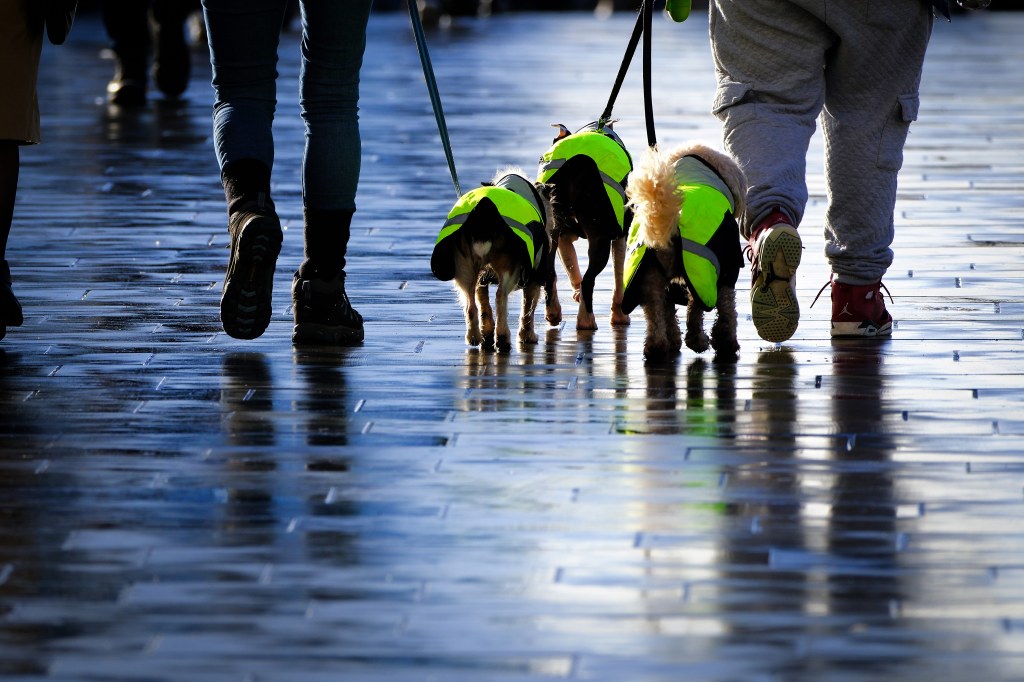
Shot with Fujifilm X-H2S (1/680sec, ISO 640, F10) Photo Credit: Andy Blackmore
Fujifilm X-H2S – So many features
As I scrutinize the gargantuan instruction manual for the Fujifilm X-H2S I internalise this; Houston we have a slight problem here. As I’ve said, I’m a press photographer, and as such, I am a creature of habit, tending only to use a central core of settings. So, as I read on discovering such bells and whistles as advanced filter settings and endless custom settings, that 40fps shooting rate and the multifarious subject-recognition tracking modes, I’m stuck by this thought. Never in a month of Sundays will I ever use them all professionally, let alone describe them to you.
So let us stick to the facts as I’ve established them so far, whilst shooting the images you see before you. In a nutshell, the focusing system is simply mind-blowing. No more hunting for focus, it works and it works brilliantly in all light levels. Consider the image of the Christmas tree, taken when I was tasked at short notice to shoot a front page that captured Christmas in the City.
Adrenalin has me searching the half-light of the City and lurking in the shadows of Leadenhall Market like some demented Sherlock Holmes on the trail of “that” image. Every second counts. No more than sixty minutes elapsed from rushing out of the office to finding that shot and it being placed on the page. This was no time or place for the autofocus to let me down. Or start hunting. Confronted by the Christmas tree in the gloom, the Fujifilm X-H2S functioned without fail. Locking on and finding focus in conditions where my Fujifilm X-T3 would have struggled and failed, once again the X-H2S gets a huge tick in the box.
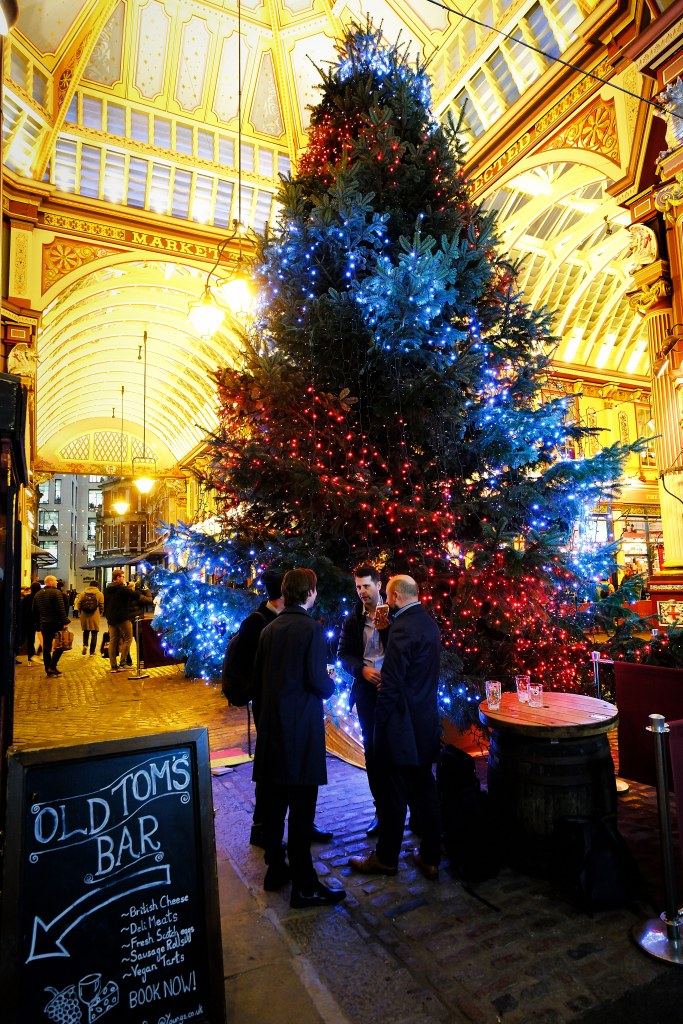
Shot with Fujifilm X-H2S (1/25sec, ISO 1000, F2.8) Photo Credit: Andy Blackmore
Fujifilm X-H2S – Professional performer
As I paint a pen portrait of what’s beginning to strike me as a thoroughly professional piece of kit, I realise this. Across the board and whatever the challenge we faced, the camera has yet to let me down, and I think I’m falling for its charms. Which in a way strikes me as curious. You see, as someone who adored the old traditional hybrid analogue/digital interface of the Fujifilm X-T3, I’d convinced myself that I was going to hate this new one – all command dials and shortcuts. I don’t and after a few days, it seems quite natural and it’s the Fujifilm X-T3 that now seems strange.
Another thing that now seems quite natural is shooting at higher ISOs. That’s because the 26.2 MP files created by the stacked sensor are sublime. Normally, I shoot in raw and use Photoshop to create JPGs via Alien Skin. For reasons that are far too convoluted to explain here, the Apple OS I’m locked down to on work devices means I’m unable to process raw files from the X-H2S. So I’ve been working directly from the in-camera processed JPGs (Film Simulation Velvia/VIVID), with corrections in Photoshop. That issue aside, I’ve consistently been struck by the quality of the files at all ISOs, especially in the higher ranges.
The camera looks and feels good and the viewfinder is a dream in providing an outstanding viewing experience, whilst the rotating rear screen is simply brilliant – perfect for those low-angle shots of commuters on London Bridge. The build quality is excellent and I’m more than confident it will stand up to all the abuse it would get if it were one of my working bodies. As it’s only on loan I try to treat it with as much respect as possible. But whilst this is a noble intention, when shooting professionally it’s not always achievable.

Shot with Fujifilm X-H2S (1/300sec, ISO 200, F22) Photo Credit: Andy Blackmore
Another huge factor in the professional arena is that as you flick the power switch it starts up immediately, and then responds instantly to all the physical controls. I can’t tell you how many shots I’ve missed waiting for a body to spring into life, so whatever the boffins at Fuji have done, they’ve done it brilliantly. And in the process, they have created a camera that has an amazing professional synergy.
So back to those core settings previously mentioned. In terms of performance, white balance etc. and all the exposure modes, the responses are boringly predictable. And that’s just how you want things. Almost all my exposures have been bang on the money, and on the odd occasion where I’ve felt they’ve been less than perfect, it’s been a simple job of exposure compensation.
To explore as many of the settings as possible, I’ve tried and successfully shot at a whole range of frame rates. Nonetheless, as one rarely encounters businessmen or women blasting through the City at speeds approaching that of light, I’ve been unable to utilise the 40fps speed. However, I’m confident that if I ever did, the Fujifilm X-H2S would be up to the job of capturing it.

Shot with Fujifilm X-H2S (1/120sec, ISO 800, F8) Photo Credit: Andy Blackmore
Fujifilm X-H2S – The final word
All reviews and opinions are subjective, and sometimes from the reviewers’ perspective, it’s difficult to put your finger on exactly what it is that makes you favour one camera over another – why you hate one yet indeed fall madly, truly, deeply for another. Perhaps in this case it’s something as simple as “The whole is greater than the sum of the parts”. Whatever, I like it. No – I love it.
However, photography is how I make money (perhaps ‘make’ is too strong a choice of word here, so let’s just say, given today’s economic climate, it at least slows the rate at which I lose funds). So whenever I consider any photographic purchase, in my head, I need to build a rational business case justifying its place in my universe. Now, I don’t expect you to hear that tortured internal monologue where I weigh the pros and cons. In this case, you don’t have to.
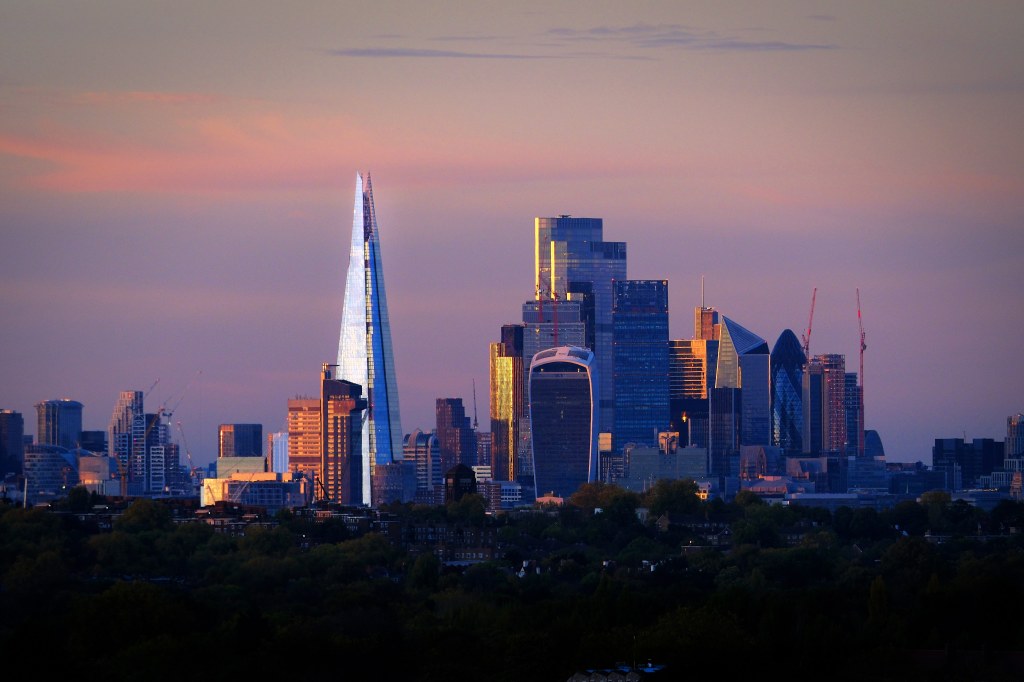
Shot with Fujifilm X-H2S with XF150-600mmF5.6-8 lens (1/250sec, ISO 800, F7.1) Photo Credit: Andy Blackmore
It’s a no-brainer. If you are a press photographer who wants a bigger bang for his buck, and given the range and quality of the lenses available – especially the amazing XF150-600mm F5.6-8 R LM OIS WR – this is the system for you.
I mean that so sincerely that just as soon as I can afford it (and admittedly that may be some time), I’m going to put my money where my mouth is and buy one. You see, in comparison to some brands I’m not going to mention here, the Fujifilm X-H2S is a bargain. Who needs full frame when you have a system that punches way above its weight like this?
Ignoring the anomaly that is the Leica M11 (for which, sadly, despite hours of arguing with myself trying to justify it, no coherent business case for procurement exists, aside from simply “I want one”), the Fujifilm X-H2S is now my favourite digital camera, and possibly the best I’ve ever used.
Read our full review of the Fujifilm X-HS2.
Related content:
- Best cameras for photojournalism and documentary in 2023
- Best Fujifilm cameras to buy in 2023
- Save up to $800/£700 on Fujifilm cameras and lenses this summer
Follow AP on Facebook, Twitter, Instagram, YouTube and TikTok.

